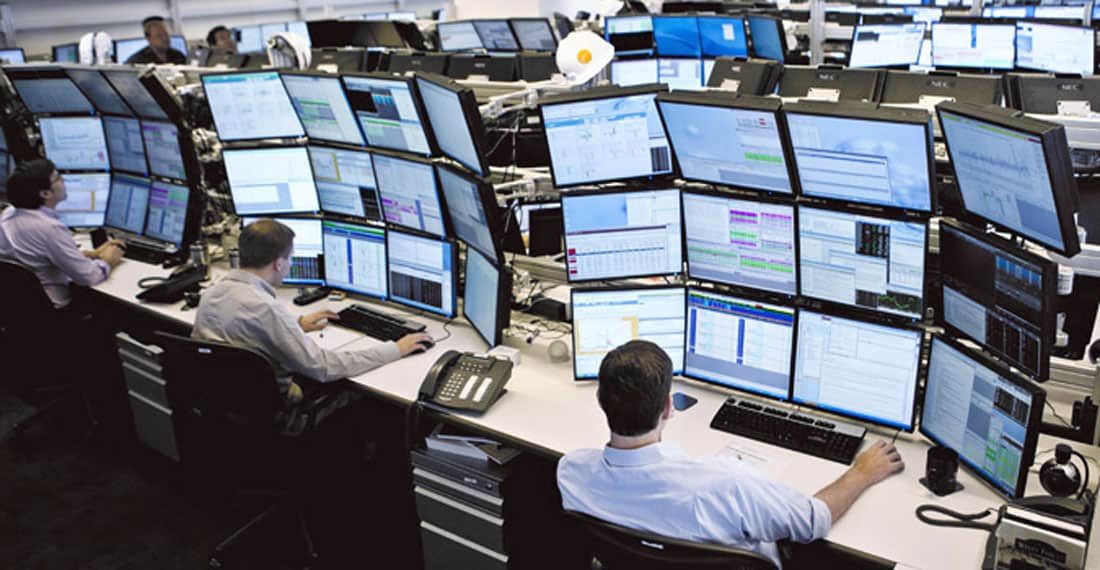
Stocks closed lower on Wednesday after trading in a wide range again as interest rates climbed back toward multi-year highs.
The S&P 500 pulled back 0.5 percent to 2,681.66 after rising as much as 1.2 percent, logging its biggest one-day reversal since February 2016. The Dow Jones industrial average closed 19.42 points lower at 24,893.35, notching its biggest reversal since August 2015. The index rose as much as 381 points and fell as much as 127 points.
The indexes began losing steam in afternoon trade shortly after a rise in the 10-year Treasury yield, rekindling the worry that sparked this cascading market plunge last Friday.
“That’s probably the biggest thing happening here,” said Dave Lutz, head of ETF trading at JonesTrading, referring to the rise in yields. He also noted the rise — which followed a lackluster auction — pressured stocks earlier in the session.
The 10-year yield traded at 2.845 percent as of 4:02 p.m. ET.

Yields also rose after Senate Majority Leader Mitch McConnell said leaders have reached a two-year budget deal which would increase current spending caps by roughly $300 billion.
“I think it was on the budget deal but it wasn’t helped by the soft auction,” said John Briggs of NatWest, referring to the move in yields. “You could get a scenario where the curve steepens. And there’s a flight to quality in the short end and in the long end, it would be rising, in terms of deficits and supply weighing on the long end.”
The Nasdaq composite dropped 0.9 percent to 7,051.98 as some of the major tech stocks pulled back. Amazon, Facebook and Alphabet all closed down at least 1.8 percent. Apple also fell 2.1 percent.
The latest moves come after three volatile sessions in which fear of rising inflation sent interest rates higher, pressuring equities. Traders also blamed computerized trading and sharp moves in obscure volatility funds that use leverage for the market’s recent swings.
“I think this bull market is basically in the process of forming a top,” Ruchir Sharma, chief global strategist at Morgan Stanley Investment Management, told CNBC’s “Squawk Box” on Wednesday. “This is the first crack of it.”
“Bull-market tops tend to be a process, not an event,” he said. “The reason why this is likely to play out this year is the trifecta which has been driving global stocks over the last 12-to-18 months as a big tailwind is now bound to turn into a headwind.” The trifecta Sharma refers to is better-than-expected global growth, weaker-than-expected inflation and loose monetary policy.
On Friday, the Dow and S&P 500 capped off their worst weekly performance in two years after a stronger-than-expected jobs report sent interest rates higher. The decline on Wall Street picked up steam on Monday, with the Dow plummeting 1,175 points as investors rushed for the exits in the wake of higher rates. On Tuesday, the 30-stock index swung 1,167.5 points before closing 567 points higher.

“This was a good old correction and one that was probably needed,” said Michael Arone, chief investment strategist at State Street Global Advisors, noting stocks kicked off the year trading sharply higher.
But despite Tuesday’s sharp close higher, the Dow is down 4.3 percent since Friday. The S&P 500 and Nasdaq, meanwhile, are down 4.5 percent and 4.1 percent, respectively, since then.
“What’s interesting is market volatility had been so low and the market just kept going up,” said Cooper Abbott, chairman of Carillon Tower Advisers. He also noted the market will start to see more volatility it “returns to normal.”
The Cboe Volatility index — widely considered the best gauge of fear in the market — has also been all over the map this week. On Monday, it more than doubled from 17.34 to 37.32. It also hit 50 on Tuesday before closing at 29.98. On Wednesday, it traded at 26.41.
A decline in stocks usually leads to a rise in volatility, but never like this. The latest spike in volatility could point to a big problem on Wall Street, some traders believe. Trading algorithms and levered fund products may have separated this market from past historical patterns, causing moves to be exaggerated.
In corporate news, earnings season remained in full swing Wednesday with Hasbro and Michael Kors reporting before the bell. Hasbro posted better-than-expected earnings. The stock rose nearly 9 percent after falling more than 4 percent in the premarket.
In economic news, Chicago Fed President Charles Evans said that no rate hikes are needed before mid-2018.
Dallas Fed President Robert Kaplan said in Germany that rising U.S. wages may not push inflation higher. His comments countered widespread market speculation that the briskest wage growth in almost nine years in the United States would drive up inflation, paving the ground for further policy tightening by the Federal Reserve.

